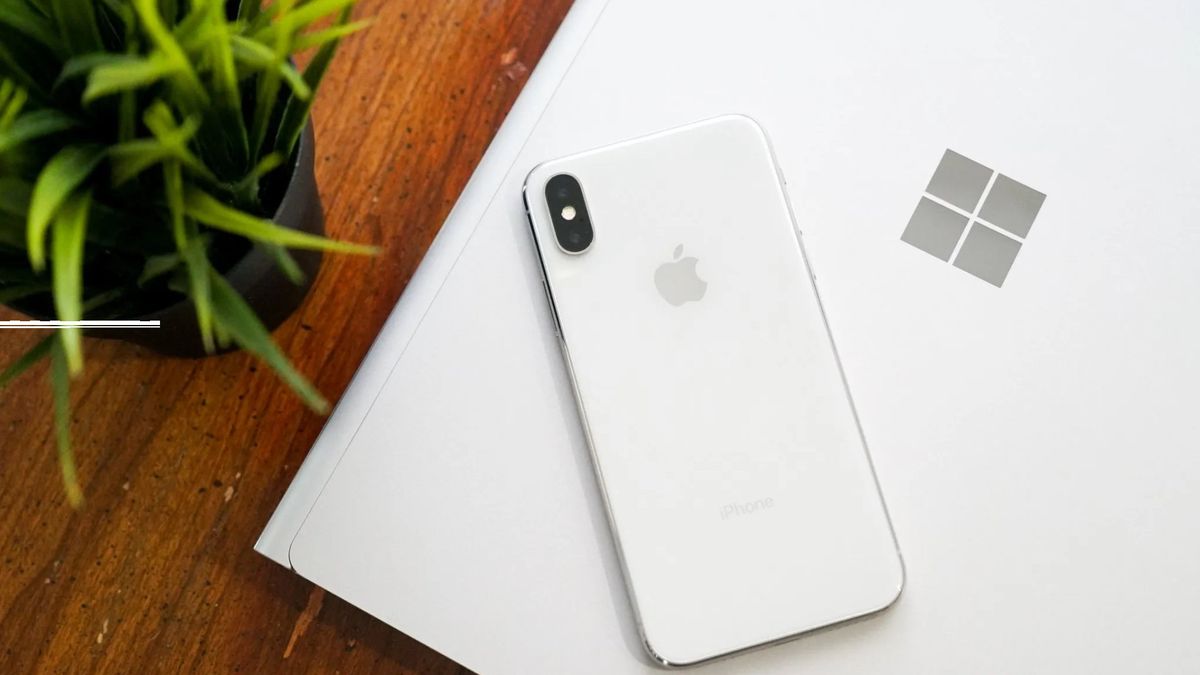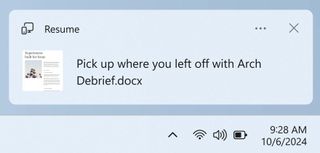Windows 11's "Handoff" clone is official, and it works with iOS or Android
A new feature called "Resume" makes it easy to keep working on documents from your phone.

Windows 11 is about to copy an excellent feature from the Apple ecosystem. Soon, you'll be able to click a notification on your PC to continue working on a document you edited or viewed on your phone recently. The feature has actually been in testing among Windows Insiders for a while, but Microsoft did not document the feature with its current name until quite recently with the release of Windows 11 Build 27788 to the Canary Channel.
There are two sizeable updates in this build of Windows 11. Build 27788 is the first to include a preview of Windows MIDI Services, which is a rewrite of MIDI on Windows. The core MIDI protocol has not seen a major update since 1983. MIDI 2.0 is much more modern and provides musicians greater control than the original version. Following the update, Windows 11 can work with MIDI 2.0 and modernizes MIDI 1.0.
Windows 11 Build 27788 also includes support for "Resume," which is a OneDrive feature that allows you continue working on a file you edited recently on your phone. The feature will show a notification for any document you've viewed or edited within the five minutes before you unlocked your PC. You can click the notification to open the document in its corresponding app on Windows 11.
The new feature that allows you to pick up where you left off is now called "Resume," but it used to have a different name. For a short time, the feature was called "Continue from Phone." Microsoft then called the feature "Hand Off." That second name was suspiciously similar to a macOS feature called "Handoff" with similar functionality, which makes me wonder if Microsoft had to differentiate its feature from Apple's. Eventually, Microsoft settled on "Resume," which is what the feature is called in the most recent documentation from Microsoft.

When I saw Resume noted in the recent Build release notes, I was curious if it was related to "Continue from Phone," So I checked with well-known Windows 11 feature expert phantomofearth. They confirmed that Resume is Continue from Phone but under a new name.
At least for now, Resume is limited to Word documents, Excel spreadsheets, PowerPoint presentations, and certain content within OneNote. The feature only works if your PC was locked when you opened a document on your phone.
Below are the change log sections related to the two largest additions seen in Build 27788. Microsoft also notes the build's fixes and other changes in the release notes.
Get the Windows Central Newsletter
All the latest news, reviews, and guides for Windows and Xbox diehards.
Windows 11 Build 27788: MIDI update
Windows MIDI Services Public Preview
We’re excited to release the first in-box public preview of Windows MIDI Services, our complete rewrite of MIDI on Windows with a focus on a great experience for musicians and a strong foundation for future expansion and enhancement.
MIDI is the standard, first released in 1983, that is used to synchronize synthesizers and drum machines in almost all modern electronic music. It’s used to record and play back note information, control stage lights and effects, keep mixers in a large venue in sync, and so much more. Although it is not itself audio, the MIDI protocol is essential to making music and was heavily used in the rise of hip-hop and other genres. MIDI 2.0 is the first major update to the core MIDI protocol since 1983, offering everything that modern musicians need today, like increased speed and fidelity, better control of instruments, modern bi-directional conversations and negotiation between instruments, discovery, better USB timing, and more.
Windows MIDI Services is our new MIDI stack which handles not only MIDI 2.0 but also brings our MIDI 1.0 implementation up to modern expectations. It works on 64-bit operating systems on all supported processors, including Arm64. Windows MIDI Services offers the following benefits:
- Full support of the MIDI 2.0 Standard, including high-speed data transmission, higher-fidelity messages, increased resolution for controller values, and full in-service MIDI 2.0 endpoint discovery and protocol negotiation.
- Faster transports, leading to better timing and reduced jitter.
- Faster USB MIDI driver with full support for both MIDI 1.0 and MIDI 2.0.
- Every endpoint is now multi-client, meaning multiple apps can use a device at the same time.
- Better endpoint and port
- In-service scheduling of outgoing timestamped messages, and timestamped incoming messages, for apps using the new Windows MIDI Services App SDK.
- Built-in loopback and app-to-app MIDI
- Automatic translation between MIDI 1.0 and MIDI 2.0 based on API, application, and device needs.
- Much more device metadata available to applications.
- Better device add/update/remove notifications.
- Backwards compatibility with our WinMM (MME) MIDI 1.0 API (and WinRT MIDI 1.0 in the future) enabling applications to light up with new features without any changes, and even access MIDI 2.0 devices at a MIDI 1.0 feature level.
- Open source. The MIDI Service, all its transports, all the tools, the tests, and the SDK are all MIT-licensed open source, and have been developed in concert with hardware and software partners around the world.
New USB MIDI 2.0 Class Driver: The new USB MIDI 2.0 Class Driver, graciously provided to Microsoft by AMEI (Association of Musical Electronics Industry of Japan) and written by AmeNote, is a high-speed USB MIDI driver which works with both the new USB MIDI 2.0 devices, as well as with class-compliant USB MIDI 1.0 devices. By default, for compatibility, this is enabled only for USB MIDI 2.0 devices and a handful of USB MIDI 1.0 devices. However, you may manually assign this driver to any class-compliant USB MIDI 1.0 device yourself to gain the better transfer mechanisms. We also have several built-in transports for things that were not previously available without third-party drivers. Learn more about the built-in transports here.
Windows MIDI Services App SDK and Tools: Applications using Windows MIDI Services do so through the Windows MIDI Services App SDK, shipped out-of-band. Current preview releases are available on our GitHub repo releases page. Please note that these are unsigned releases and so will give you a warning when you download and install. In addition to installing the required runtime components, the SDK runtime installer includes these tools:
- Windows MIDI Services Console (midi.exe): The all-around console tool for sending messages, checking the state of MIDI, monitoring incoming messages, sending System Exclusive, and much more.
- MIDI Diagnostics (mididiag.exe): A tech support tool which provides information about the state of MIDI on the PC.
- MIDI Kernel Streaming Endpoint Info (midiksinfo.exe): A hardware developer-focused tool which provides information about the KS (Kernel Streaming) endpoints.
- MIDI multicast dynamic DNS Info (midimdnsinfo.exe): A tool to support the upcoming Network MIDI 2.0 transport.
The Windows MIDI Services App SDK also includes the MIDI Settings app – a desktop application for managing endpoints, renaming endpoints and ports, creating loopback devices, managing your network MIDI 2.0 connections, and more.
In addition, we’re currently working on our Network MIDI 2.0 transport, recently demonstrated at the NAMM Show in California, the virtual patch-bay to enable routing between endpoints, and a rewrite of our BLE MIDI 1.0 transport. This will all ship in a future version of Windows MIDI Services.
We look forward to having Windows Insiders who dabble in music creation try out the Windows MIDI Services Public Preview and MIDI 2.0. Try out using existing applications that use the WinMM MIDI 1.0 function with the new Windows MIDI Services installed. Additionally, any MIDI 1.0 devices with specific IHV drivers. You can also join the discussion here on Discord if you have questions or are looking to help! You will find a list of known issues documented here.
Windows 11 Build 27788: Resume
Ability to seamlessly resume OneDrive files in 1-click from your phone to PC
We are gradually rolling out the ability to seamlessly resume working on OneDrive files from your phone (iOS and Android) on your Windows 11 PC with a single click. With this feature, you will get a notification asking you if you want to pick up where you left off editing a OneDrive file like a Word doc that you last viewed or edited on your phone within a 5-minute time window preceding unlocking your PC.
Upon clicking on this notification, the same file that you were viewing or editing previously on your phone will open in your default browser on your PC.
- This feature works only when signing into OneDrive with a Microsoft account. Work and school accounts are not supported. And you need to be using the same Microsoft account signing into OneDrive on your phone and signing into your Windows 11 PC.
- This feature supports Word docs, Excel spreadsheets, PowerPoint presentations, OneNote notebooks/pages, and PDFs.
- The OneDrive file must be opened on your phone when your PC is locked. If you then unlock your PC within 5 minutes of accessing the file on your phone, you will receive the resume notification as noted above.
- For the best experience using this feature, you should be logged into OneDrive in your default browser on your PC.
This feature can be managed and turned off via Settings > Apps > Resume.

Sean Endicott is a tech journalist at Windows Central, specializing in Windows, Microsoft software, AI, and PCs. He's covered major launches, from Windows 10 and 11 to the rise of AI tools like ChatGPT. Sean's journey began with the Lumia 740, leading to strong ties with app developers. Outside writing, he coaches American football, utilizing Microsoft services to manage his team. He studied broadcast journalism at Nottingham Trent University and is active on X @SeanEndicott_ and Threads @sean_endicott_.
-
GraniteStateColin This is nice, but I would actually find the reverse far more useful. It's easy to find a document on a Windows PC with the big screen and file navigation tools (and per-app Jump Lists). On the other hand, it can be a pain to get to a particular document on a phone. Often, I don't bother working on my phone just because of the hassle of getting to the document. If I could quickly pick up where I left off on my PC, I'd probably do a little more work every night when I go to bed.Reply -
Arun Topez I'm confused, what exactly is new? The article calls it a 'new feature' and that it's a copy from Apple, but then at the end of the article it says that this feature is just the existing 'Continue from Phone' feature renamed as 'Resume'? This feature has been around even in Windows Mobile days even before Apple (getting a notification on my PC after editing a doc on my Lumia, which then opened the UWP version of Word), and even another iteration previously named as 'Continue on PC'. Then it went away for a while. So it's really a returning feature, not really a new feature - unless there's something different with this iteration?Reply -
neo158 Ah, another Windows 11 "feature" that I guess is going to be exclusive to Samsung devices 🙄.Reply